Continuing our look at Frank Miller’s astonishing output in 1986. Between April and October Miller finished up his short-lived return to Daredevil, the title that put him on the map. He also continued work on Batman: the Dark Knight Returns, arguably the most high profile and widely read comic book in history. Even a four month delay between the third and final issues couldn’t diminish the series’ momentum.
The second half of 1986 began with the first issue of Elektra: Assassin, written by Miller and illustrated by Bill Sienkiewicz, whose wildly experimental art style complemented the hallucinatory tone of story perfectly. It started a trend for fully painted comics that lasted well into the 1990s, and paved the way for similar books such as Grant Morrison and Dave McKean’s Batman: Arkham Asylum among many others.
April 1986
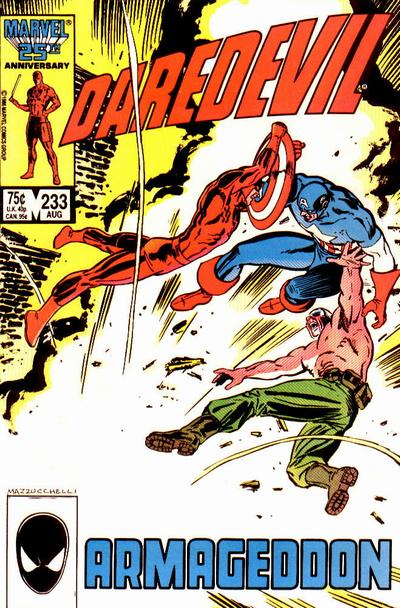
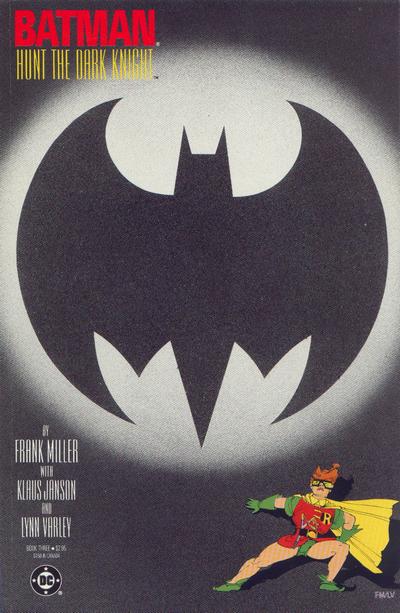
Daredevil #233 (cover date August 1986) “Armageddon”
Story by Frank Miller; artwork by Dave Mazzucchelli; color by Max Scheele; letters by Joe Rosen.
The carnage continues as Kingpin’s “borrowed” government operative Nuke lays waste to Daredevil’s home neighborhood of Hell’s Kitchen in an effort to flush Daredevil out. Miller writes the battle scene remarkably well, avoiding making the fighting look cool or romantic and instead focusing on the horror of it all. He also makes great use of Daredevil’s internal monologue to put forth an incredible amount of exposition, handling elements of the story that can’t easily be shown in the illustrations without it seeming like he’s over-explaining. Using caption boxes rather than more cartoony-looking thought balloons, we get Daredevil’s thoughts during the fight as one might imagine they’d be – disjointed, with one thought interrupting another as he analyzes his opponent while trying to keep down his horror and panic at the mounting collateral death toll.
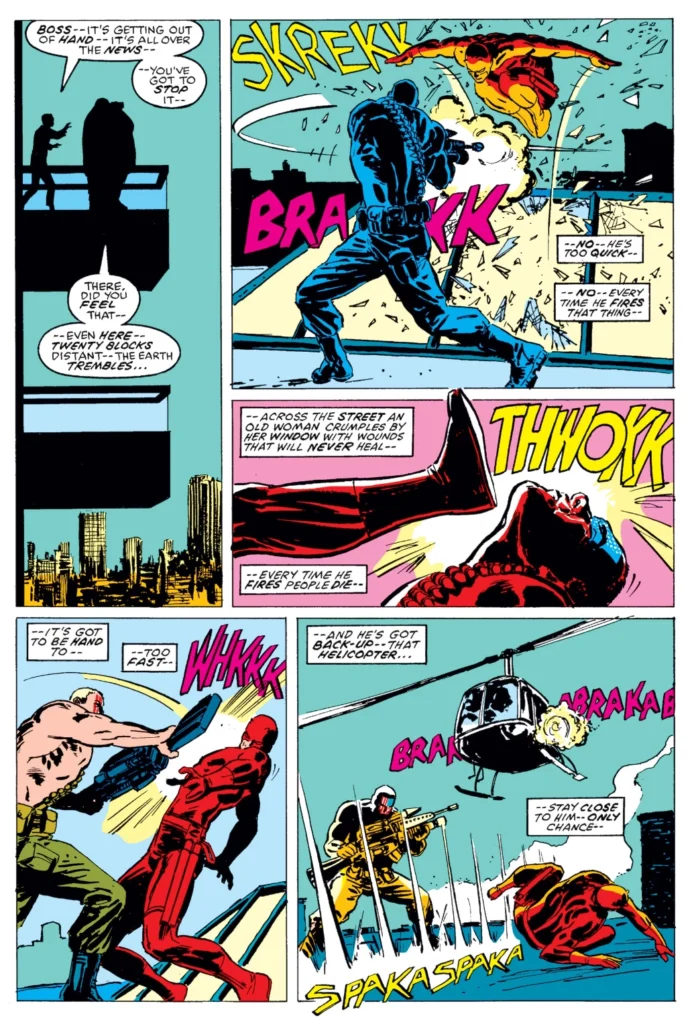
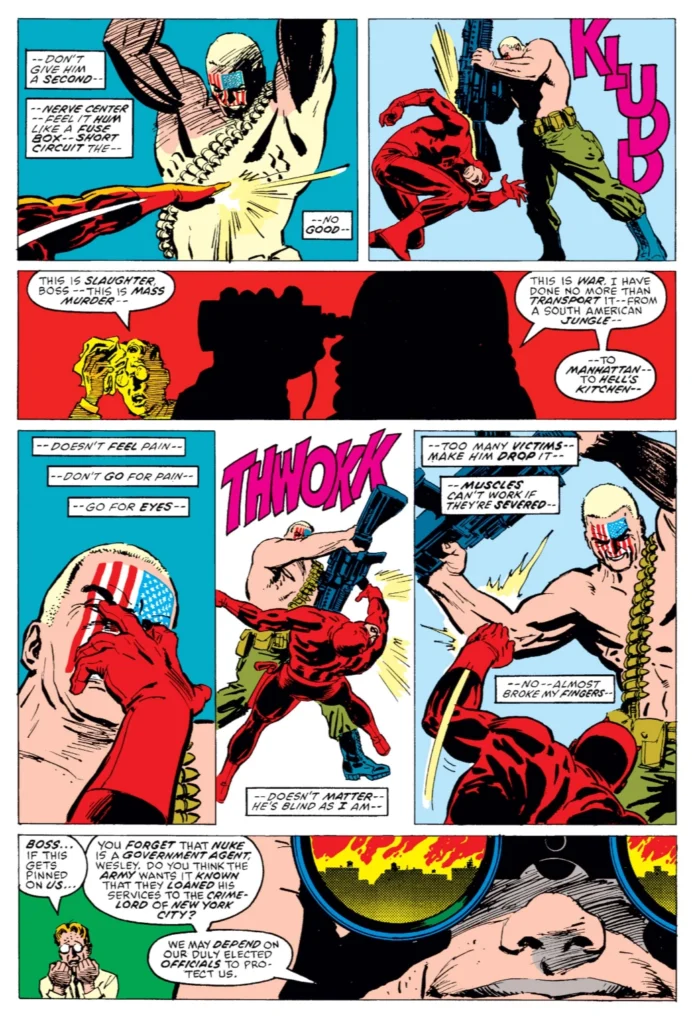
Daredevil #233 pages 3 and 4. © Marvel.
Meanwhile, the Kingpin looks on, arrogantly secure in his belief that he can continue to pursue his destructive vendetta, free from any consequences. Miller’s political leanings are pretty clear: he’s spent this series tearing down Matt Murdock, taking away his status as a wealthy lawyer and remaking him as a working class champion, while the Kingpin’s real villainy lies in his vast wealth that allows him to make his every whim a reality, and insulates him from any accountability for his actions. The fact that he is ostensibly a crime lord is fairly immaterial, it is his wealth and status that Miller takes issue with.
In addition to showing a remarkable sensitivity to the cost of indiscriminate combat in human lives, Miller addresses another key criticism that often comes up with comic book writing. With Marvel’s characters all occupying the same fictional universe, it can be difficult to escalate the jeopardy in an individual character’s story without prompting the question “well, why don’t the Avengers just show up and take care of it?” Miller answers this question by…having the Avengers show up and take care of it.
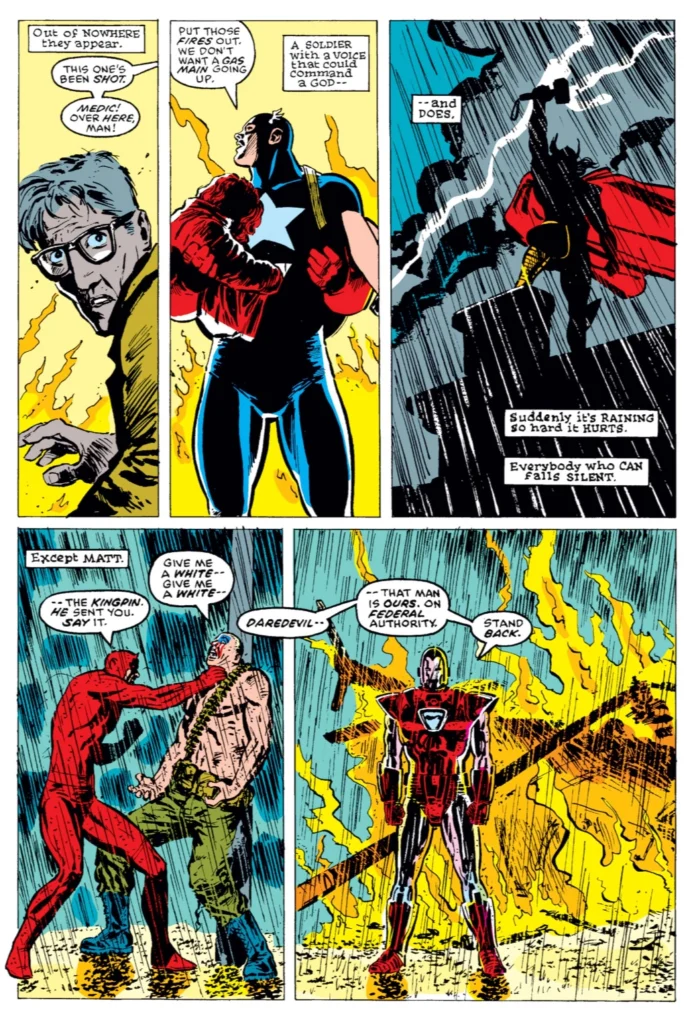
Both the writing and the artwork lean into the idea that the superhuman Avengers operate on an entirely different level from street heroes like Daredevil, and their appearance here emphasizes their otherworldliness. Captain America is handled extremely well, somewhat surprisingly given the seemingly anti-establishment nature of Miller’s politics. Miller goes to great lengths to emphasize that Captain America is about the ideal that America represents, not the current, cyincal reality. At one point he even explains to an army general “I’m loyal to nothing, general – except the dream.” Miller goes on to portray Captain America as so fundamentally decent that you have to respect him, a characterization that will soon be mirrored in a certain Man of Steel’s appearance in The Dark Knight Returns.
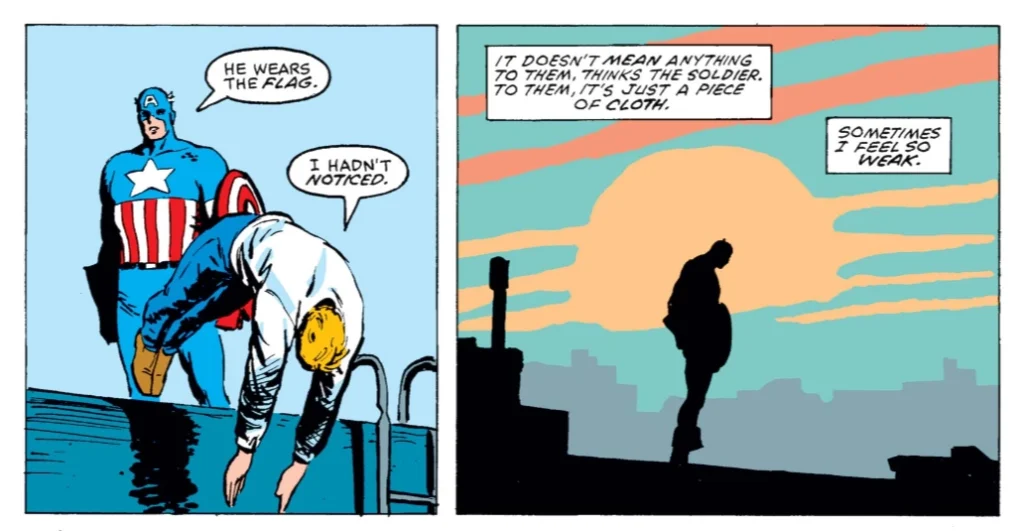
The story ends on a nice thematic turnaround. After systematically destroying Matt Murdock’s life in the first half of this story, we now see the Kingpin undergo a similar collapse. Throughout the issue we see the Kingpin finally starting to attain the one thing he really wants: respectability. But we also see that it is entirely illusory – Kingpin’s internal monologue is very clear that he is using his usual crime lord methods to make inroads into the legitimate business world It doesn’t seem to bother him that all this so-called respect wasn’t earned at all, but extorted and threatened into existence. But it does bother him when that respect is quickly snatched away, as his role in Nuke’s attack is made public and he is made to answer for his arrogance.

As the Kingpin’s schemes unravel, the story ends on Matt Murdock and Karen Page strolling through Hell’s Kitchen. If not living happily ever after, we at least see Murdock content, having settled into his new, simple life and finding that the Kingpin didn’t take away anything of value. The entire “Born Again” story, and this final issue in particular, are written with a level of sensitivity and thoughtfulness that I don’t think we ever see in any Miller’s future work. I would even go as far as to say that Daredevil: Born Again is the best thing he ever wrote.
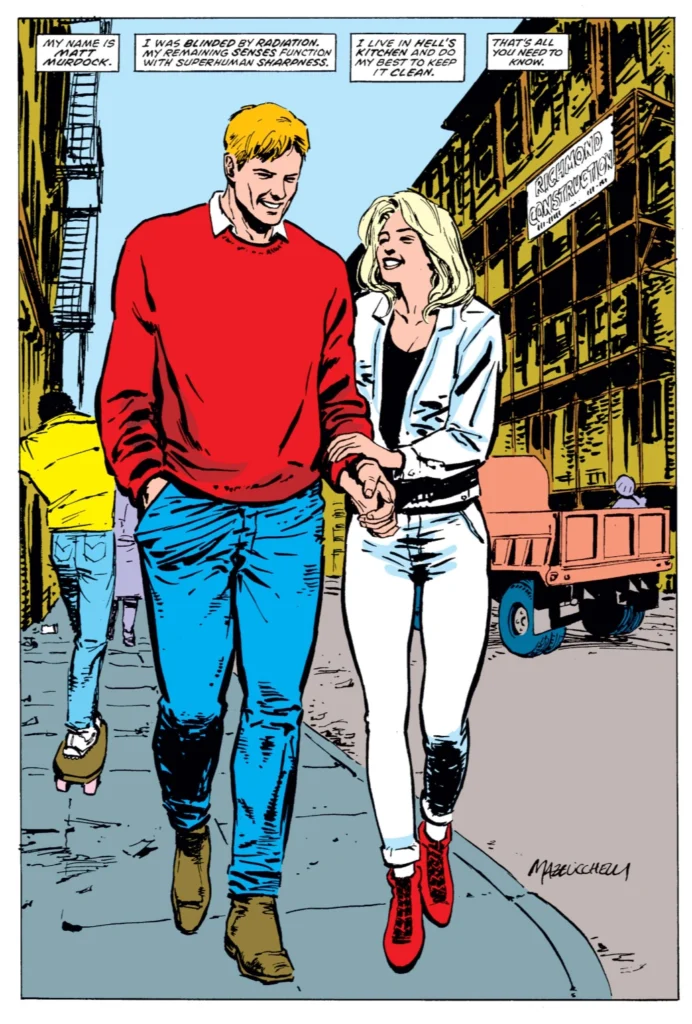
Batman: the Dark Knight Returns book three “Hunt the Dark Knight”
Story and pencils by Frank Miller; inks by Klaus Janson; colored by Lynn Varley; letters by John Costanza.
Book three introduces two larger-than-life characters that no definitive Batman story could do without. One is Superman, really the only DC comics character that could be considered an equal to Batman in terms of significance and popularity. The other is Batman’s greatest villain, the Joker.
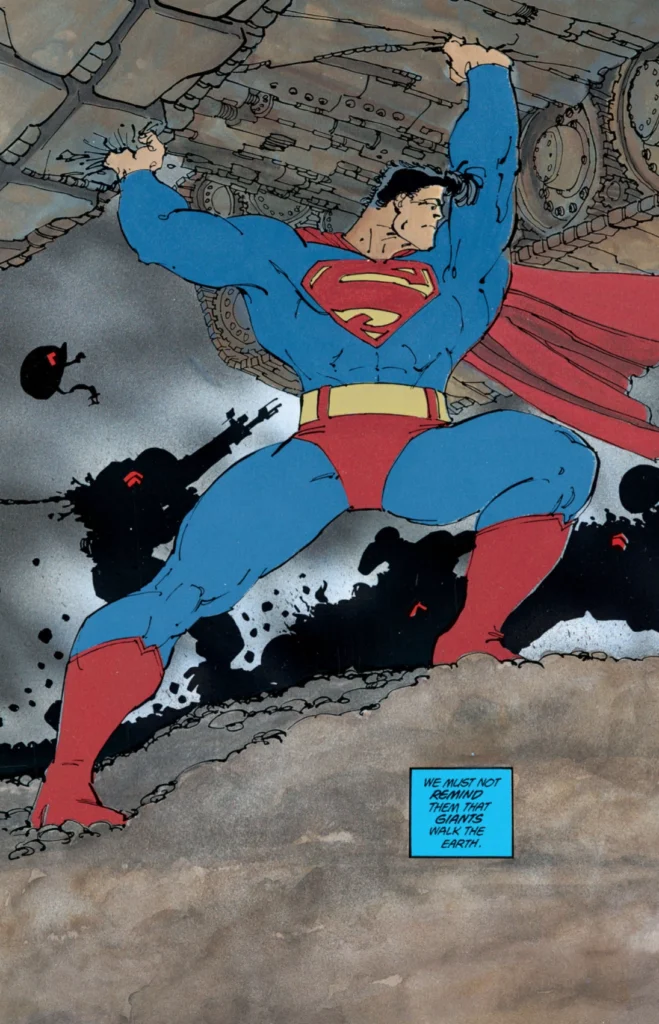
Miller’s characterization of the Man of Steel is a lot more complex than it first seems. While Superman’s status as an apparent government operative can easily be interpreted as “selling out,” his internal monologue drops some subtle hints about the circumstances that brought him to this fate. Miller is very good at giving his characters distinct internal voices, and using those voices to provide exposition that doesn’t sound like exposition – the character’s observations provide the reader with the minimum amount of detail required to understand what’s happening. He uses this technique to great effect here as Superman ponders the undefined events that forced Batman and the other superheroes into retirement, while also justifying his own decision to work for the government as the only way he could continue to use his power to save lives. It’s a sensitive bit of characterization, and while it’s clear that Batman views Superman with contempt, Miller does not seem to share that contempt. He treats the character with a respect similar to his treatment of Captain America in Daredevil: Born Again.
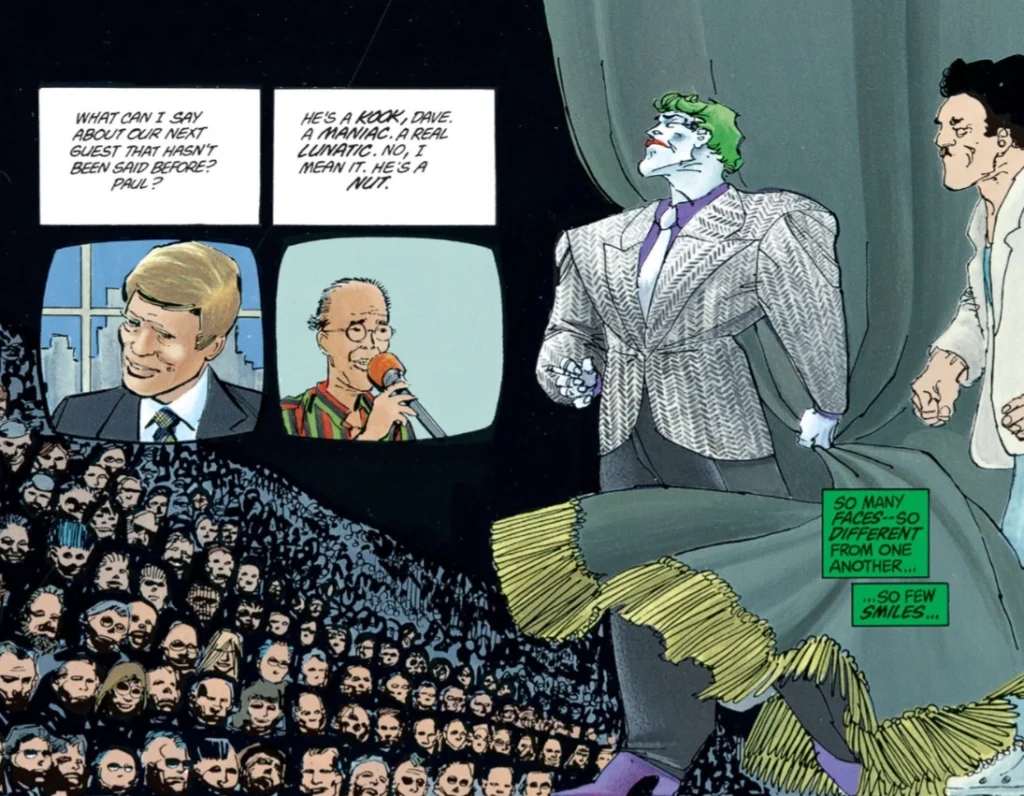
The Joker has been appearing here and there since book one, waking from what is presumed to be a self-induced catatonic state when Batman’s emergence from retirement hits the news. The idea that the Joker only exists as a reaction to Batman is reinforced throughout this issue as he manipulates his way into a talk show appearance which he of course uses to escape.
The Joker’s psychiatrist Dr. Wolper continues to be the symbol of Miller’s clear disdain for the pop psychology of the 1980s, particularly the (understandably popular) idea that therapy can somehow absolve people from taking responsibility for their bad behavior. Dr. Wolper uses textbook psychobabble to excuse the Joker’s horrific crimes, and ultimately pays the price for his hubris by unleashing a monster onto the world and dying a horrible death in the process.
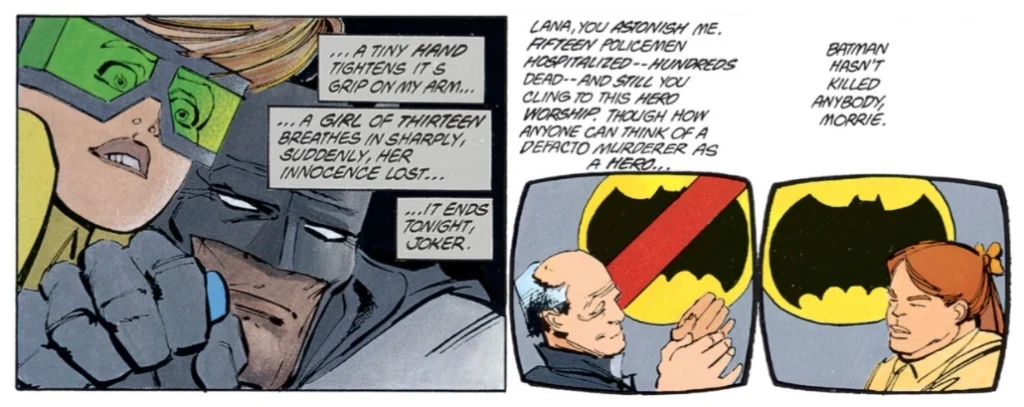
Towards the end of this issue, Miller addresses the often discussed issue of why Batman doesn’t kill. As the Joker cuts an astonishing path of death and destruction through an amusement park full of innocent civilians, Batman resolves that this will be the last time, insinuating that he’s finally going to do the unthinkable and use lethal force against his archenemy. Throughout the scene we are given the impression that this is what the Joker wanted all along, his actions calculated to force Batman to descend to his level (a theme that would be further explored a few years later in Alan Moore and Brian Bolland’s Batman: the Killing Joke).
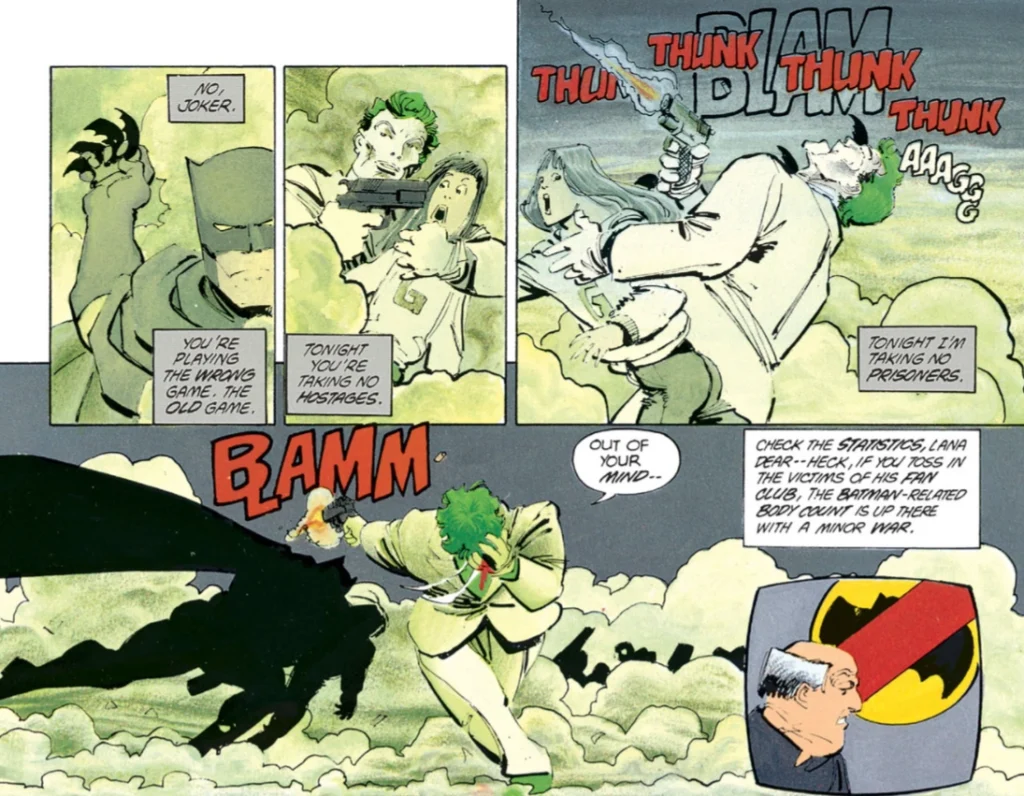
Over the course of their battle, Batman resolves not to betray his principles after all, noting that “we kill too often because we’ve made it easy…too easy…” Frustrated at his failure to goad Batman into committing murder, the Joker kills himself, knowing that Batman will be blamed for the crime.
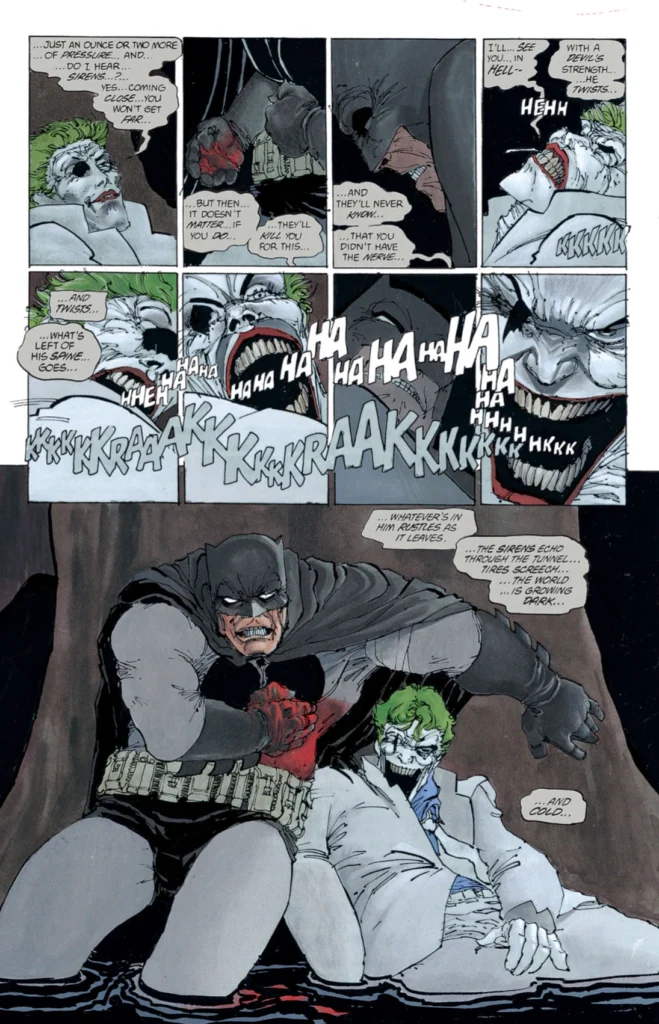
May 1986
May was a rare month off for Frank Miller fans. A two-part follow-up to “Born Again,” to be illustrated by Marvel superstar Walt Simonson, was scheduled but never happened (Miller and Simonson would later collaborate on the better than it has any right to be Robocop vs the Terminator in 1992). Miller appears to have left Daredevil somewhat abruptly, possibly over disagreements with Marvel concerning a proposed comic book ratings system that Miller interpreted as censorship. To add insult to injury, The Dark Knight Returns book four was running late, and wouldn’t hit stands until August.
However, there was a short piece about Miller in SPIN Magazine. Read more about it here.
June 1986
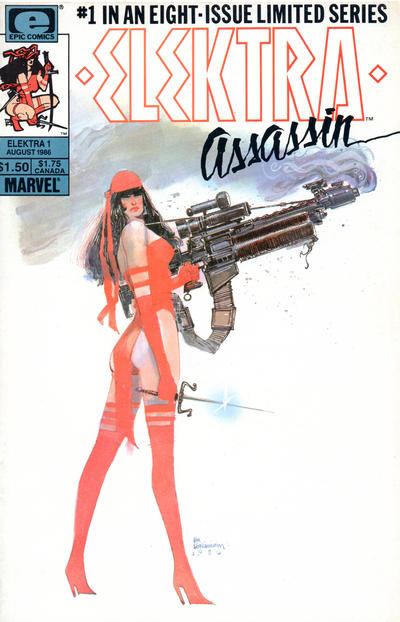
Elektra: Assassin #1 “Hell and Back”
Story by Frank Miller; artwork by Bill Sienkiewicz; lettering by Jim Novak
Having done stellar work with internal monologues from multiple viewpoint characters in both Born Again and The Dark Knight Returns, Frank Miller takes the next logical step by giving us an unreliable narrator in the form of Elektra, an immensely popular supporting character from the pages of Miller’s original run on Daredevil in the early 1980s. In a story that takes place before her death and subesquent ressurection in Daredevil #190 (cover date January 1983), we find the character in a South American insane asylum trying to reconstruct her shattered memory.
In Born Again and The Dark Knight Returns, the artwork stands as a more or less objective reality. As a writer, Miller doesn’t often need his captions to explain what is happening in the pictures, so he can instead have the characters offer their own subjective viewpoint on what is happening in the story. But with Elektra: Assassin, we have a viewpoint character whose grip on reality is constantly called into question, giving the story a hallucinatory quality. If you need a comic book to feel like a fever dream, there is no better artist than Bill Sienkiewicz.

Sienkiewicz was fresh off of a groundbreaking run as penciller and inker on Marvel’s The New Mutants, in which his style evolved dramatically to accommodate a pair of surreal, dream-like storylines (The Demon Bear Saga and Legion). For Elektra he elected to do fully painted artwork, and for the first issue he changes his style from page to page, sometimes from panel to panel, in order to better reflect Elektra’s shattered mental state. The results are electrifying, with child-like drawings for Elektra’s childhood memories contrasting with more realistic illustrations for what we assume is her current reality, with subtle differences for recent memories that we’re not certain are real or imagined.
While the artwork is intensely impressionistic and surreal, it is also very clear and surprisingly easy to understand. Elektra’s internal monologue helps move that along a little, not necessarily by explaining the pictures but by giving them context. It’s an incredible way to tell a story, and it’s only possible in comics.
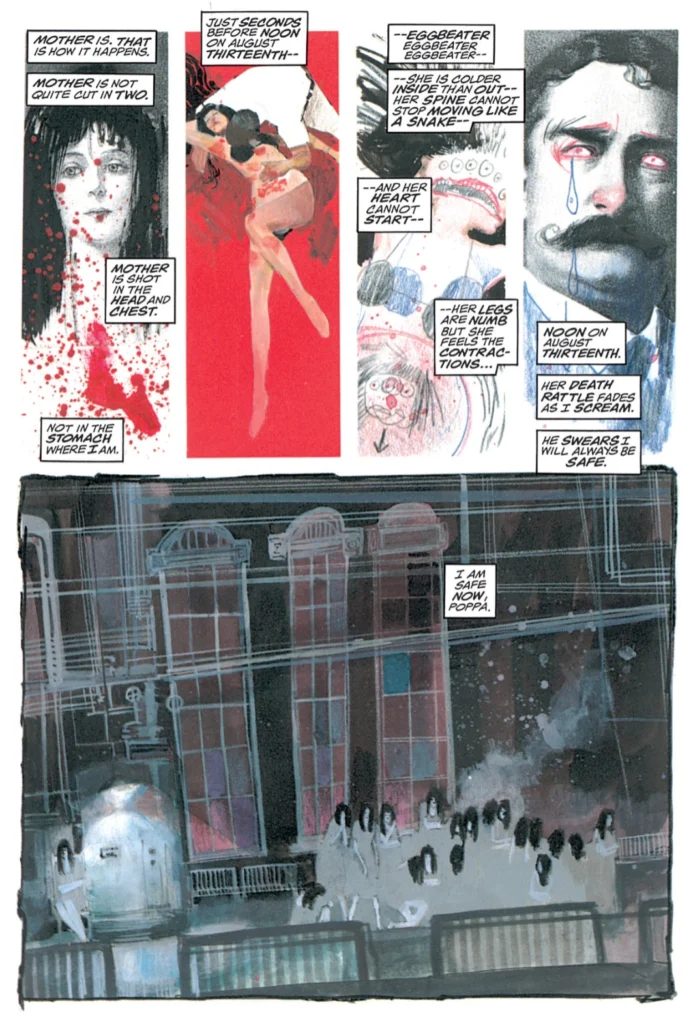
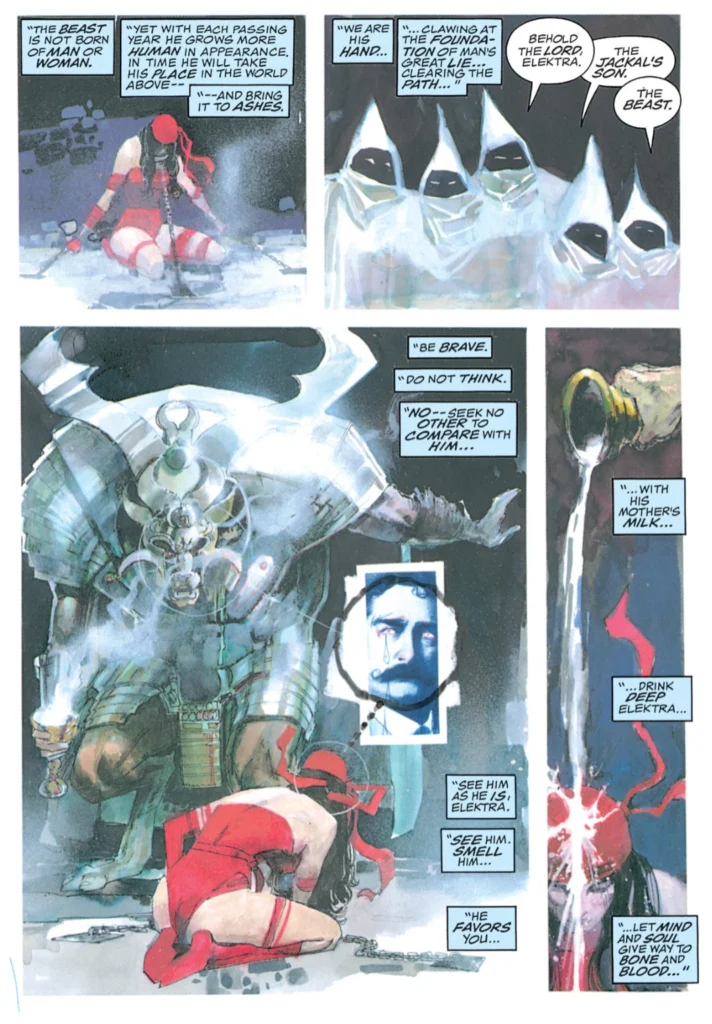
Elektra: Assassin #1 pages 4 and 19. © Marvel.
As Elektra wanders through her scattered memories, we get a brief recap of her story so far: the daughter of a high ranking Greek diplomat, Elektra has a brief love affair with Matt Murdock while they’re both in college. Her father is assassinated, causing her to withdraw from the world and eventually attempt to join an order of warrior monks led by Stick, the blind pool hustler who taught Daredevil to use his powers. Stick’s order trains Elektra for a time, but eventually rejects her, causing her to join their opposition, the Hand – a ninja cult ruled by a supernatural figure known as The Beast.
Elektra eventually leaves the Hand to work as a freelance assassin. While on a job in South America, she detects the presence of The Beast in a U. S. ambassador, and while attempting to escape from a botched attempt to kill this ambassador that Elektra finds herself locked up in a mental institution. The final sequence of the first issue jumps back and forth between Elektra’s recent memory and her current situation. As she pieces more and more of the story together, she becomes more lucid and aware of what is happening to her, and the disparate art styles start to mesh. It all leads up to a spectacular action sequence in the final three pages of the issue as Elektra effects her escape.
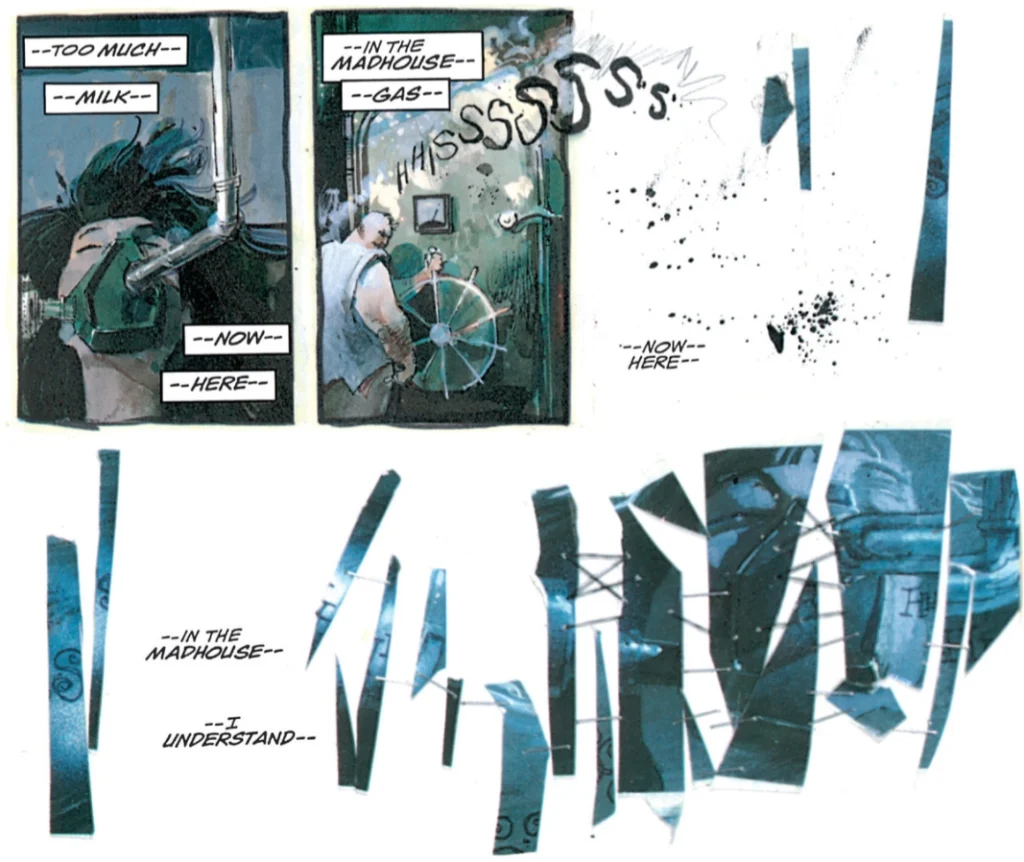
July 1986
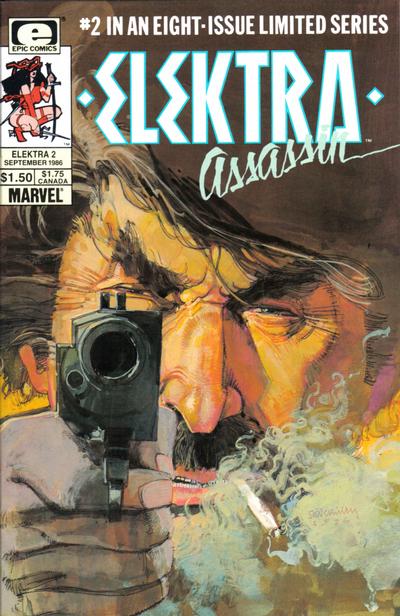
Elektra: Assassin #2 “The Ugly Man”
Story by Frank Miller; artwork by Bill Sienkiewicz; lettering by Jim Novak
“Imagine Rashomon done featuring only characters whose sanity was in question.”
– Frank Miller, speaking about Elektra: Assassin in Amazing Heroes #99, July 1986
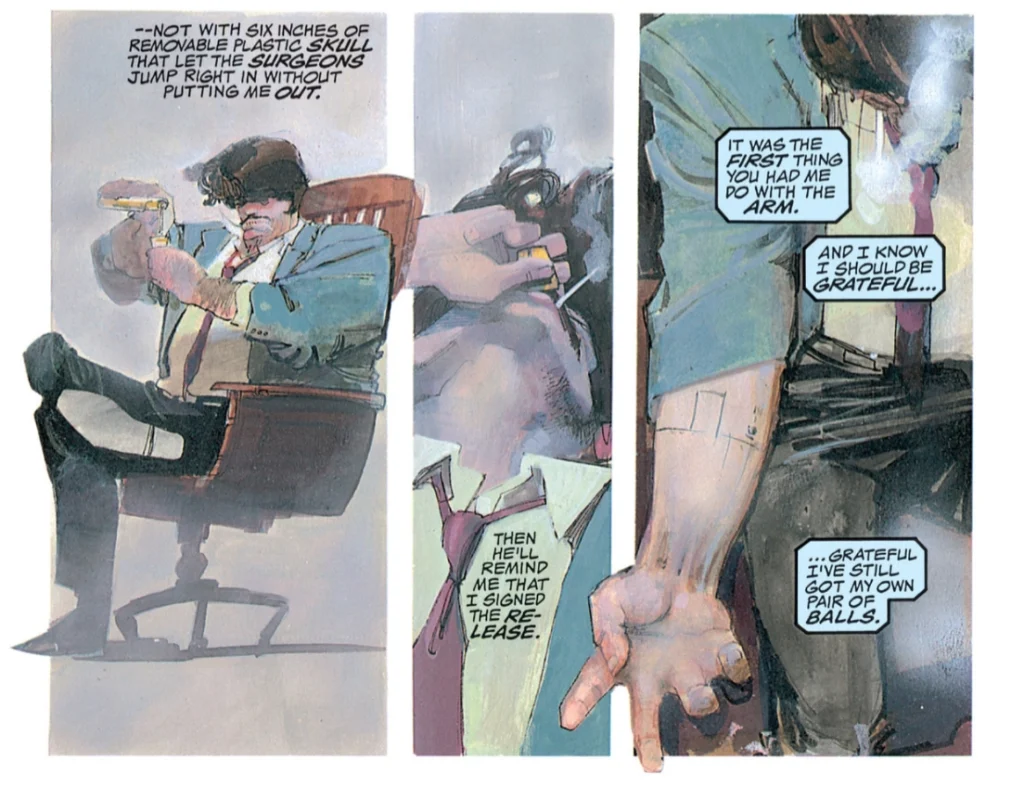
In issue 2 we are introduced to our second unreliable narrator: John Garrett, an agent of SHIELD (the top spy organization in the Marvel universe) with a cybernetic implant in his brain and a moral compass that is questionable to say the least. Before we meet Garrett, however, there is a relatively whimsical sequence in which Elektra, having escaped from the mental institution, happens upon a film set and liberates a drugged out lion. Her sympathy for the abused creature serves to soften her a bit, which is especially important in a story where the ostensible hero is a deranged murderer for hire.
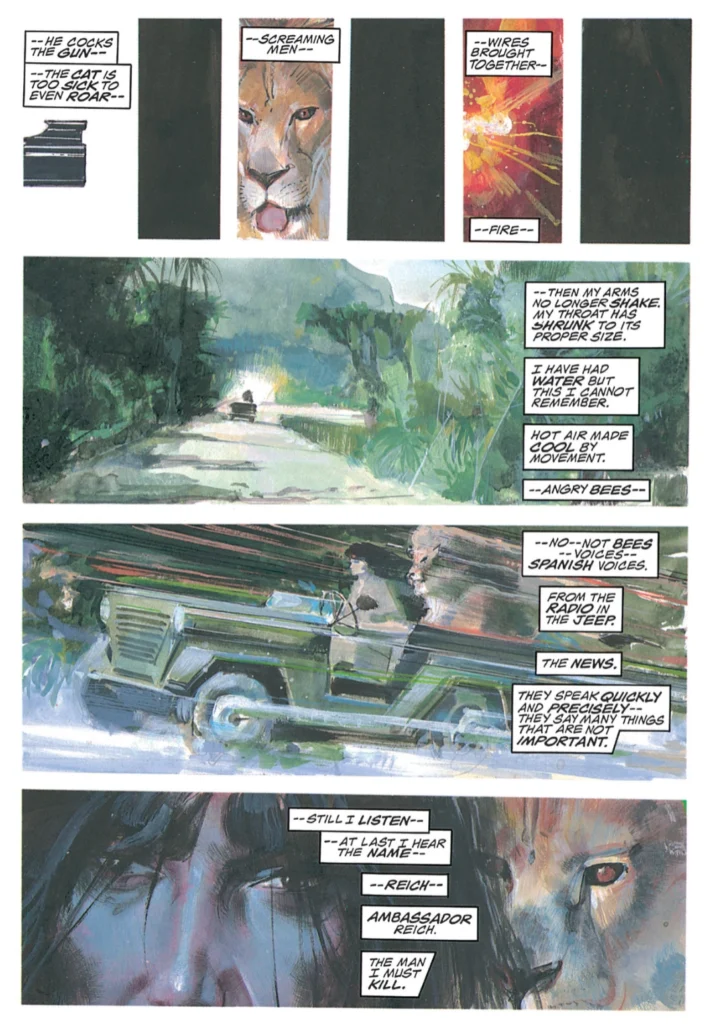
The changes in artwork style are less pronounced, reflecting Elektra’s improved mental condition and the fact that she is more or less living in the present moment, with only occasional, brief flashbacks. Her internal monologue still indicates that her grip on reality may be tenuous, but also refreshingly simple – she has resolved to destroy The Beast, and she proceeds with an earnest lack of cynicism. It calls to mind Matt Murdock’s embracing of his simplified circumstances at the end of Born Again; Miller seems to be seeking a catharsis in the face of the increasingly cynical and complicated reality of the 1980s.
The narrative jumps ahead, and we finally meet Garrett. The implant in his brain allows SHIELD to record his thoughts and memories, and this is where things get really interesting. We have Elektra, an extremely unreliable narrator, watching and interpreting Garrett’s memories, which are another level of unreliable narration thanks to his almost cartoonish level of world-weary cynicism. Sienkiewicz complements this by rendering Garrett, and his even more sociopathic partner Perry, in an exaggerated style, making him into a parody of 1980s masculinity.
As Elektra continues to read Garrett’s recorded memories, Garrett and his partner are put onto her trail. The two narratives circle each other, but there is never any doubt about who has the upper hand. Even with her scattered memory and tenuous grip on sanity, Elektra is terrifyingly competent, while Garrett and Perry are buffoons who are only effective against severely disadvantaged opponents.
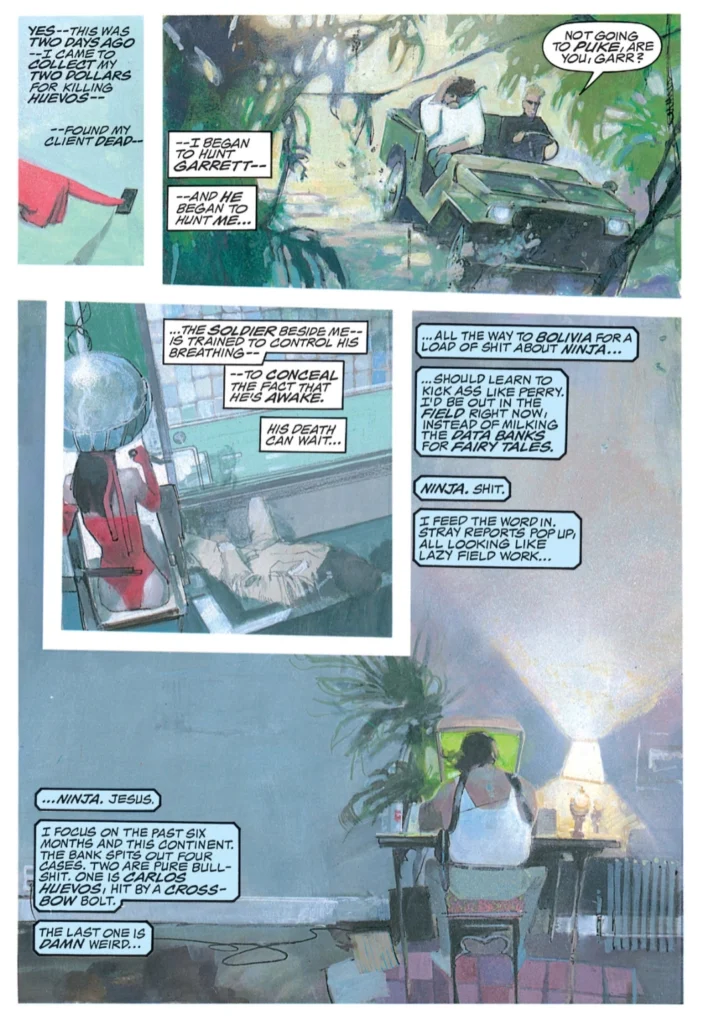
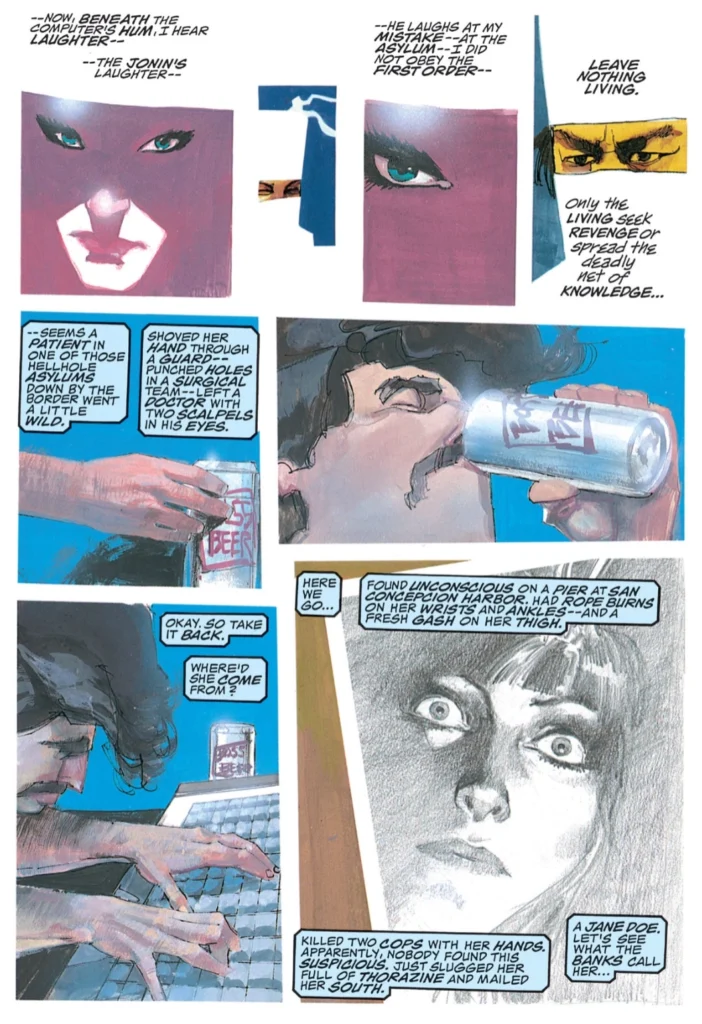
Elektra: Assassin #2 pages 18 and 19. © Marvel.
A very strong recurring theme in Miller’s work is the idea of an independent and highly competent operator working against a stagnant, corrupt establishment. We see it here with The Beast operating right under SHIELD’s nose, just as we see it in The Dark Knight Returns with Batman being the only one able to fight against a hopelessly corrupt and ineffective government and society, or even Daredevil abandoning being a lawyer in favor of a more direct approach against the Kingpin, a criminal who hides his evildoing behind corporate protections.
The twin narratives get closer and closer, until finally Garrett catches up with Elektra, but she is still one step ahead of him. Their first physical confrontation is rendered entirely with Garrett’s captions against empty panels, effectively illustrating his confusion as she literally takes him apart. The pacing of the action is so fast that to provide an actual illustration of what is happening would slow it down too much.
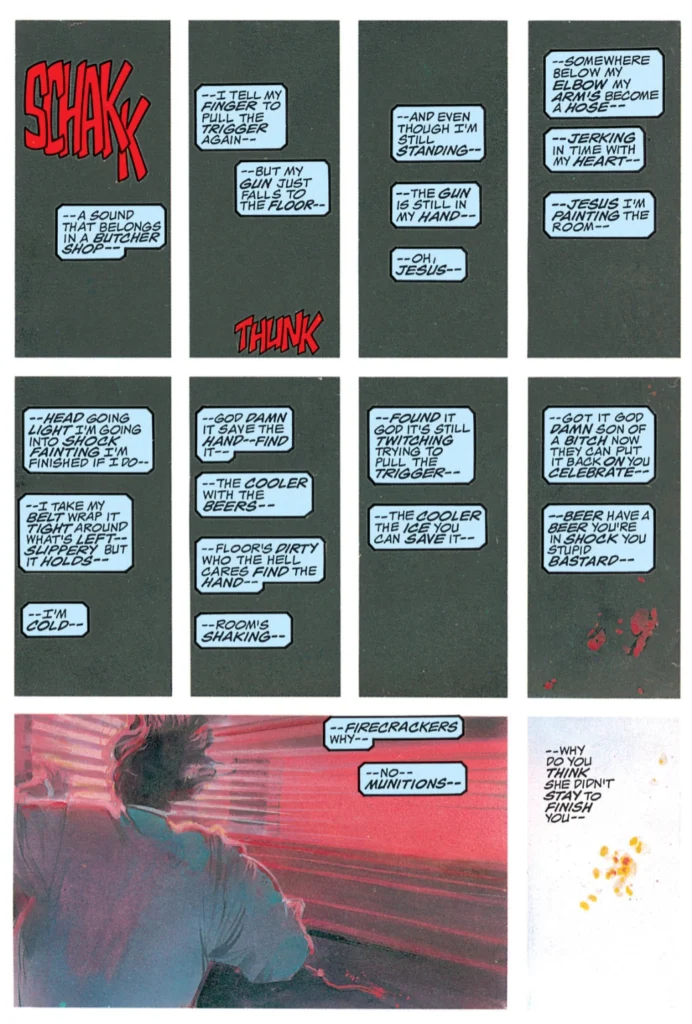
All through this sequence we’re reminded that we’re actually seeing Elektra viewing Garrett’s memory of his encounter with her, which means that he has miraculously survived being dismembered and blown up. Meanwhile, Elektra’s infiltration of the SHIELD facility where she’s reading Garrett’s memories hasn’t gone unnoticed…
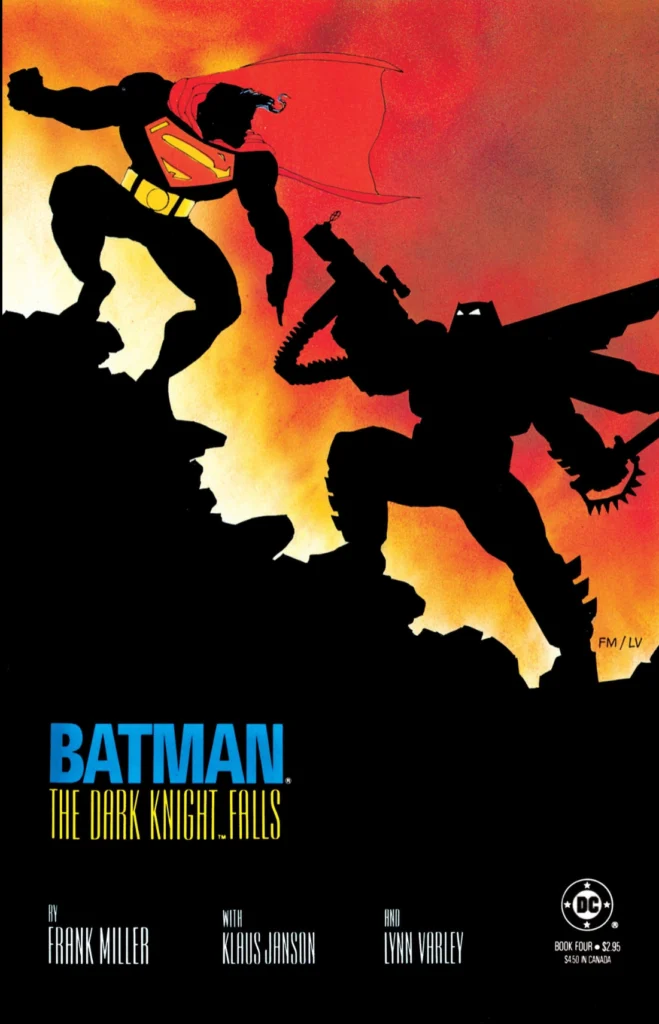
Next time:
The Dark Knight’s story comes to and end, Elektra’s gets a little more coherent, and we find out just why the Kingpin was so angry at Daredevil in the first place…
Batman: The Dark Knight Returns cover art by Frank Miller and Lynn Varley. © DC Comics.
